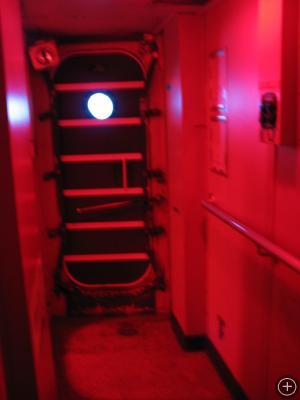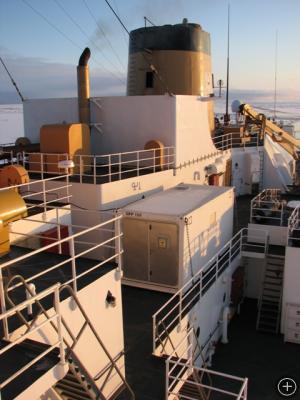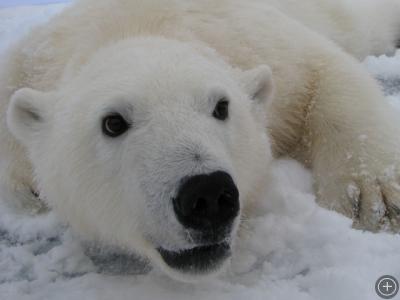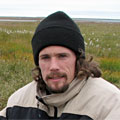Catching Our First Bears, Based on a Tiny Floating City
ABOARD THE USCGC POLAR SEA, ON THE ARCTIC OCEAN– We have all adjusted quickly to life on a ship, but every once in a while, it is still quite striking to remember that we are on a very small, floating city, in one of the most remote places on earth. There are peculiarities about living on a ship that make everything just a little different. Overnight, dim red lighting is used not just on the bridge but throughout the ship. Every night at 10pm a general announcement (a “pipe”) comes over the PA system throughout the ship: “Taps taps, lights out, taps taps”, and the ship is darkened.

Because we are so far north, sunrise is already very late – occurring today at 1007am. Because we are so far west, almost to the international date line, sunset is also surprisingly late. I took this photo after 8pm. Daylight is visible through the porthole on a door, but the interior is already lit with overnight red lighting.
Unexpected aspects of life at home also come up. Tonight after dinner, I managed to watch some of the Minnesota Vikings – Green Bay Packers football game (I am from Minnesota). A satellite television signal is received on the ship with the Armed Forces Network, which shows some sports. The reception can be pretty sporadic however, and we lost signal in the 4th quarter. The Vikings were ahead…I hope they won.
I have begun to develop a mental image of the layout of the compartments of the ship (and, thankfully, I can finally find my room without the help of someone nice enough to stop and ask if I am lost). Everything is close here – the mess deck, our berths, our lab space – but connected by a maze of hallways and steep stairs. Walking around outside on the upper decks gives the impression of close-set apartment buildings in a city skyline.

The skyline, viewed standing on a weatherdeck near the bridge facing towards the back of the ship (aft).

Standing over the bridge and looking down on the bow of the ship as we slowly break ice in the evening. The red flag is flown in windy and icy conditions, to judge how the wind may affect the path of the ship and the movement of the ice.
We flew several days in the last week, locating bears for recapture. However most bears were traveling on thin, newly forming sea ice, which is unsafe for capture operations. We really need some colder weather to thicken the ice. Most days have been around 30 degrees (Fahrenheit), although the last two days have periodically dipped down to 21 degrees. Two days ago we finally had our first recapture. We relocated an adult female with her 10 month-old cub as they were traveling on good, thick ice. The capture went well, and we were able to repeat all of the sampling from her first capture, which occurred in May. It was excellent to see this bear again and collect samples that will tell us what she has been doing over the last 5 months. In overall appearance, she and her cub had good body condition. After breaking ice for several days to reach these bears, we will keep the ship in this general area hopefully as colder weather helps expand and solidify the ice pack.

We had a successful capture today as well. This female cub is only 10 months old but already weighs 211 pounds.
It is remarkable that the lack of good, thick ice has been such a problem for us. It was a problem that we considered before this trip but we did not think it would be so common. The ship has a chart of the Arctic that was printed in 1954, and it shows the average location of the ice edge in summer – several hundred miles south of our current position. Until recent years our current position would have been deep into the Arctic ice, rather than near the edge in patchy ice.










Very the Vikings won!
I love the red lighting and the pictures turend out very well.I love the one you have of the female cub.